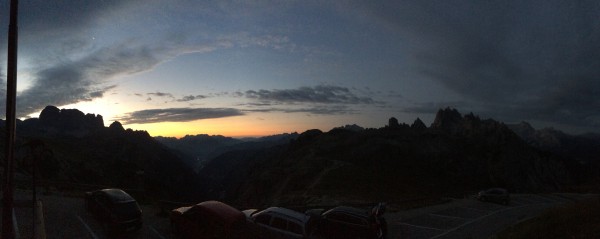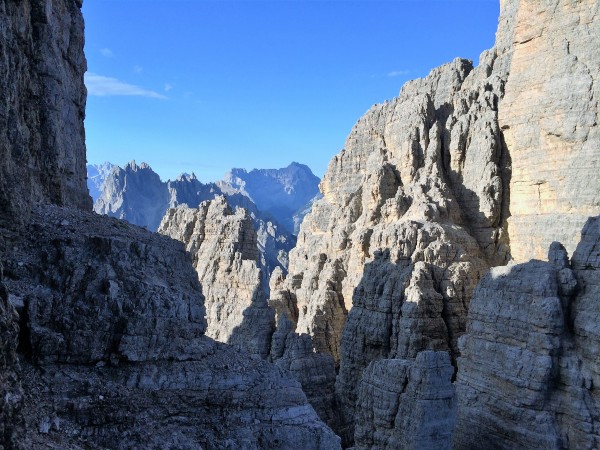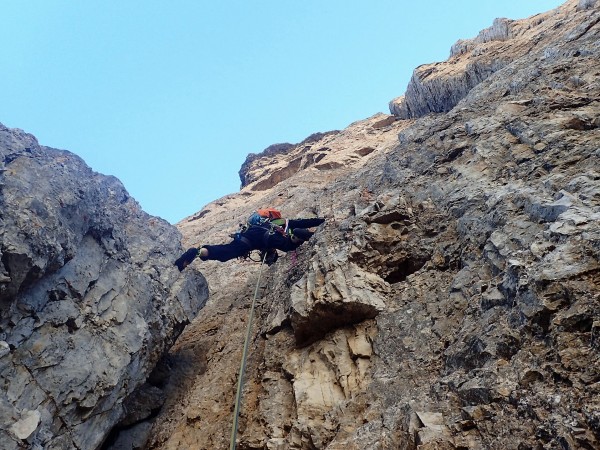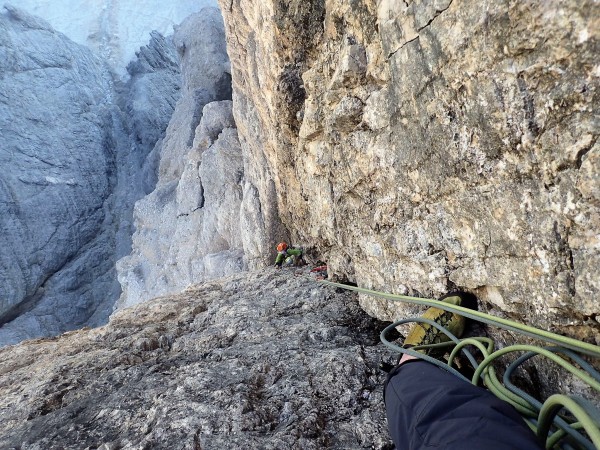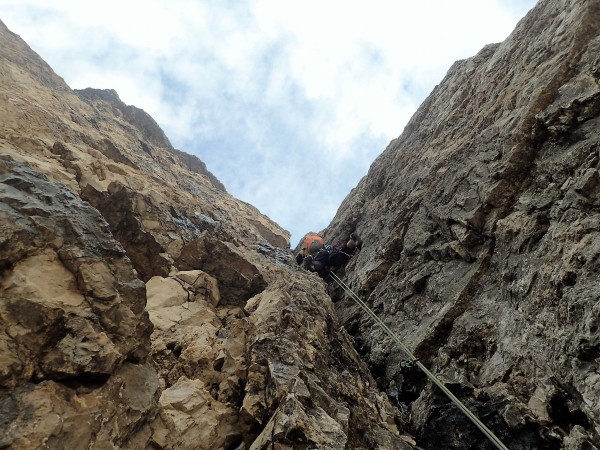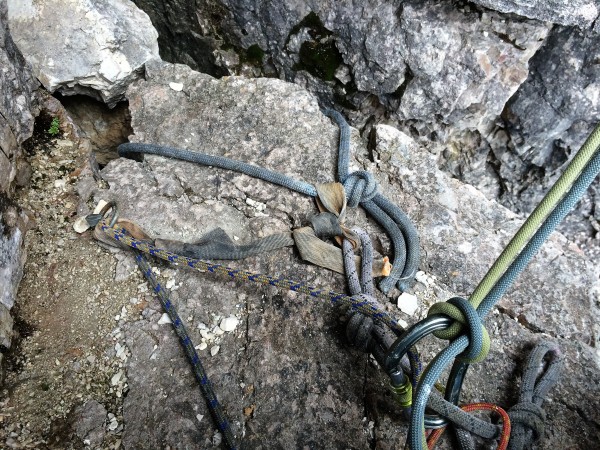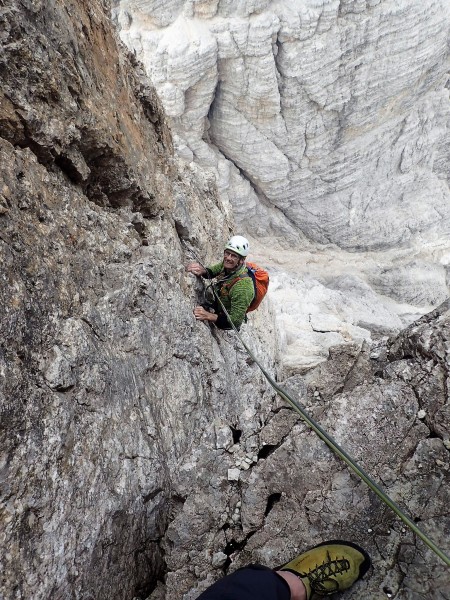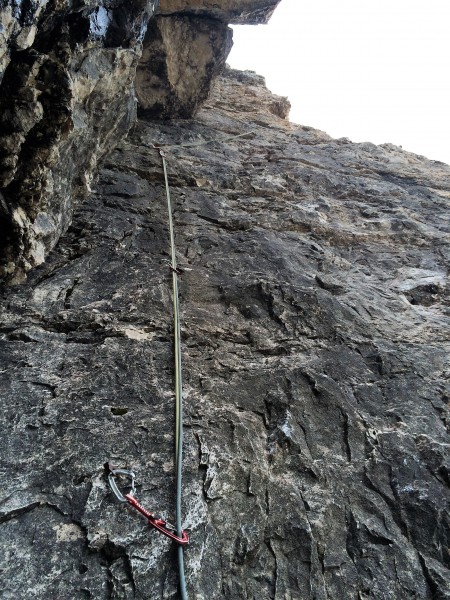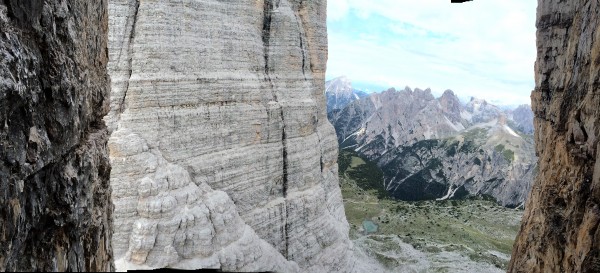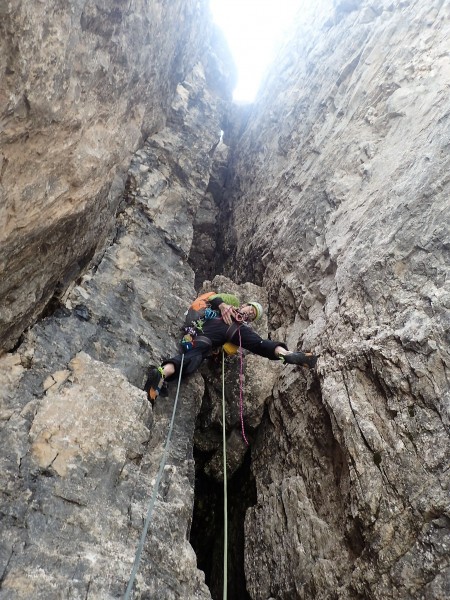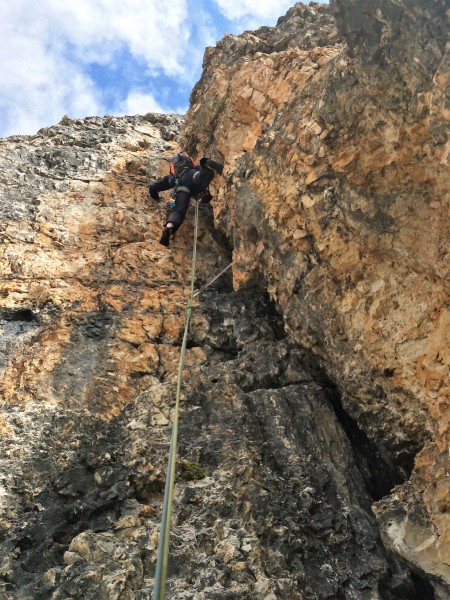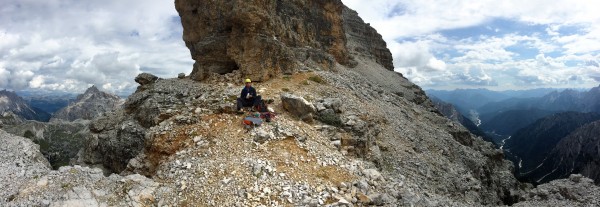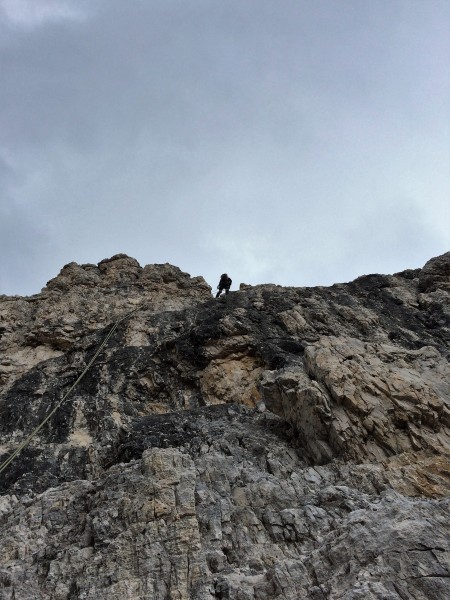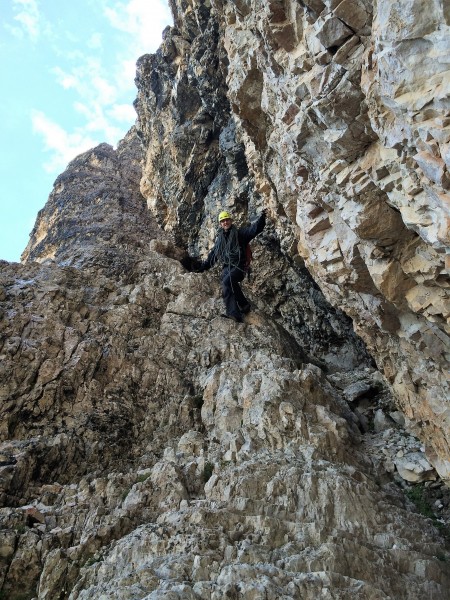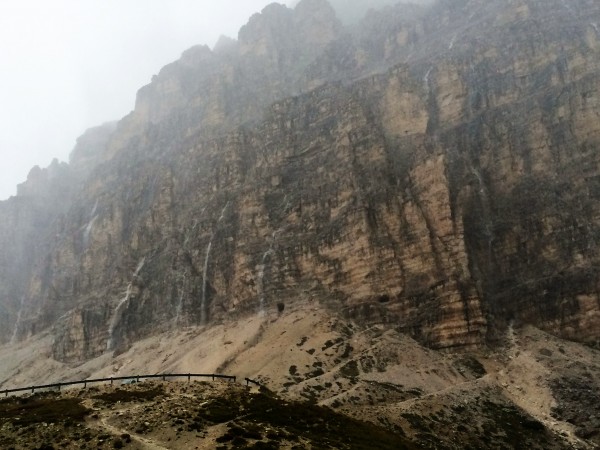
Missing photo ID#470689
On the morning of 18th of August 1913, two hardy souls began scrambling up the gully that divides the South walls of the Cima Ovest and Cima Grande. Their objective was a corner line on the West Face of Cima Grande, that would ultimately deposit them on the Summit. The two were the Austrians Hans Dulfer, and Walter von Bernuth, given their talents the approach gully would have been no obstacle. Soon they would have been at the ledge at the base of the West wall, an impressive location with a dizzying drop down the North face immediately to your left. Scoping out the best way to reach the corner line which started some 30 meters above them. The corner shoots up for 80m or so before being blocked by a huge chock stone which blocks entry into the wide chimney and walls above.

Missing photo ID#470691
They were travelling light, they are recorded as taking a rope (Hemp or Sisal) three pitons and two new fangled carabiners. I’ve found no record of what they were wearing on their feet, either rope soled slippers, or nailed boots. Regardless they made quick work of the route, with Dulfer leading all the pitches, (The current description with modern ropes describes seven pitches to the Ringband - Dulfer probably did more shorter pitches - another four or five lead to the top). The pair thus established in five hours a new grade V+ (5.8), on an iconic Dolomite peak. Given the minimal gear, and nature of the route, much of it will have been lead with no gear, there are no spikes or chockstones on the pitches to thread, and I suspect at least one peg would have been reserved for the belays, Probably with the rope threaded through the eye, or a sling, leaving one peg to use on the pitch with a carabiner.
It was and is, a stunning achievement, by two climbers at the top of their game. They would have descended the ‘Normal Route’, nowadays much of this is done by abseil. Given their equipment and talents they will probably have down-climbed all of it. Dulfer, along with his contemporaries Paul Preuss, Tito Piaz, Sepp Innerkofler and others of that period were an amazingly bold and talented group of climbers. If you have any interest in the history of climbing the period is very worthy of study. It is quite humbling.
Like Innerkofler, Dulfer was a victim of WW1, killed at Arras on the Western Front on the 15 August 1915 (two years and three days after the West Face), killed either in an artillery barrage or by a grenade. Von Bernuth survived the war - his climbing diaries ‘1909 -1920 Tourenbuch’ have been published, but my investigation hasn’t turned up much else.
So on the night of the 28 August I find myself sleeping in the front seat of a Fiat Punto in the Refugio Auronzo car park, behind Tre Cime. The hut is locked and discomfort and a thunderstorm are conspiring to keep me awake. My partner Mike is also pretending to be asleep. Around four the rain stops and the sky clears, prompting me to try for a more comfortable couple of hours alongside the car.
I doze until dawn and eventually accept the futility of trying to sleep, likewise Mike is awake and we kill time waiting for the hut to open so we can get some breakfast. Promptly at seven in opens and we gulp down some breakfast and coffee, return to the car and rapidly sort out kit. Today we will do the West Face of the Cima Grande, it will allow us to scope out the descent of our main objective, the Comici on the North Face. Though we might need a lot of favours from the weather gods as after a week of fine weather, our holiday has thunderstorms racked up for each day.
Having sorted out the gear we set off on the approach which takes you through some spectacular scenery, towering pinnacles, complex gullies, tottering scree and slippy limestone paste!. Eventually we arrive at the narrow col, between the Cimas Ovest and Grande. Here we pass a WW1 sentry post! Some more scrambling leads to the base of the route on a ledge that overlooks the North Face, and the East Face of Cima Ovest.
Mike came up and scoped out the start to the corner, which was running with (cold) water and covered in a thin black slime. He carefully got established and with a combination of slippery laybacking and careful bridging arrived after 35m or so at a hanging stance. A very steady lead given the conditions.
I followed, the next pitch continued up the corner and was similarly wet and the crack black and slimy, despite the size of the crack there wasn’t much gear to speak of, much of what I was carrying seemed superfluous, It was easier than Mike’s pitch but it still demanded care. Thankfully it deposited me on a decent ledge, with a good belay. 20m above the chockstone loomed.
Mikes pitch took a compact grey wall rightwards to bypass the chockstone, clean and dry it sported three pegs, but was a lot easier than the corner below, he shot off up it and soon was at his belay, on top of the chockstone.
Above loomed a wide chimney, supposedly ‘IV’ is was indeed at the start straightforward, and I was seduced upwards without paying too much attention to protecting the pitch. I reached an awkward bit and looked down at my pro 20’ below and made a mental note to be careful….. It was all a bit of a thrash, and went on longer than it should, but eventually dragging a reluctant rope I emerged onto a ledge system and belayed below another ‘IV’ corner. Mike came up and continued up the line, belaying where it seemed convenient. We were now ‘off piste’ as far as the description went. But in a couple of more pitches landed on the Ringband from where we would begin our descent.
The weather was glorious, blue sky and warm, we had some lunch, peered over the North Face and scoped out the three bivi shelters.
Focused as we were on the descent (and being in a gully) we hadn’t noticed the ‘cloud’ - we could not but help notice the loud crack of thunder, rain and hail which announced the arrival of an early thunderstorm. We donned our waterproofs and continued. The storm was short lived and by the time we reached the base it had passed, and we were quite pleased with ourselves and the way we had managed the descent. Eventually we reached the gully separating the Cima Piccola from Cima Grande, we were safe. Our Reverie however, was broken by the classic Dolomite cliche, in the form of a very large rock that arrived and shattered on the scree between the two of us! Mike looked at me and said ‘I just was thinking about taking my helmet off!’
This prompted as speedy a descent of the path as our aging knees would permit, and we eventually reached the track between the Laverado and Auronzo huts. We stopped in the sun and took off our helmets, sorted gear and continued to the hut.
We dropped off the kit at the car and checked in, and went for a doze in the room, it had been a long 24 hours! After about half an hour we were woken by a huge clap of thunder, opening the shutters we witnessed the arrival of the real afternoon storm (about 1 - still early) the back of the Cima Ovest was barely visible, and what you could see was sobering with with several huge waterfalls gouting onto the scree below the face. The rain hammered for a further couple of hours then subsided, but it stayed grey and miserable. (The shelters on the Ringband would provide considerable protection even in these conditions - but being caught on any climb or descent would be truly grim).
The next day dawned dull and damp, the forecast had not improved, and the hut was very expensive. We decided to cut our losses (we are nothing if not very prudent) and head out of the mountains to Arco, which we did, sport climbing, climbing shops, Pizzerias and Gellateria beckoned. The sun shone and it didn’t rain!
As to the Comici, next year maybe....
Steve
